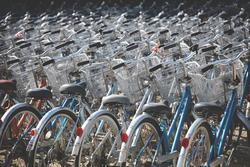 |
| Photo: Bike List |
A new report from TØI proves the Safety in Numbers effect.
Bicycle advocates and other stakeholders with an interest in arguing for a shift from motorized to non-motorized travel often rite the concept of ”Safety in numbers” (SiN) as an argument against the concern about a potential increase in numbers of accidents resulting from such a policy. The concept of SiN is used to explain the non-linear statistical relationships between the number of pedestrians or bicyclists and the number of injuries for the same group.
The Scandinavian countries, and in particular Norway are interesting cases to test the SiN effect, as there is a substantial seasonal variation in bicycle use. The seasonal variation is substantial, meaning that every spring there is a dramatic increase in the number of bicycles other road users are exposed to each subsequent week.
The risk of accidents between bicyclists and car drivers is reduced throughout spring and summer as car drivers are gradually getting used to an increased number of cyclist on the roads. Also, cyclists become better at bicycling throughout the season.
Comparing Norwegian road users with their Danish and Swedish counterparts shows that this effect can either be accentuated or reduced by differences in infrastructure quality and traffic culture (norms about how to behave to each other).





